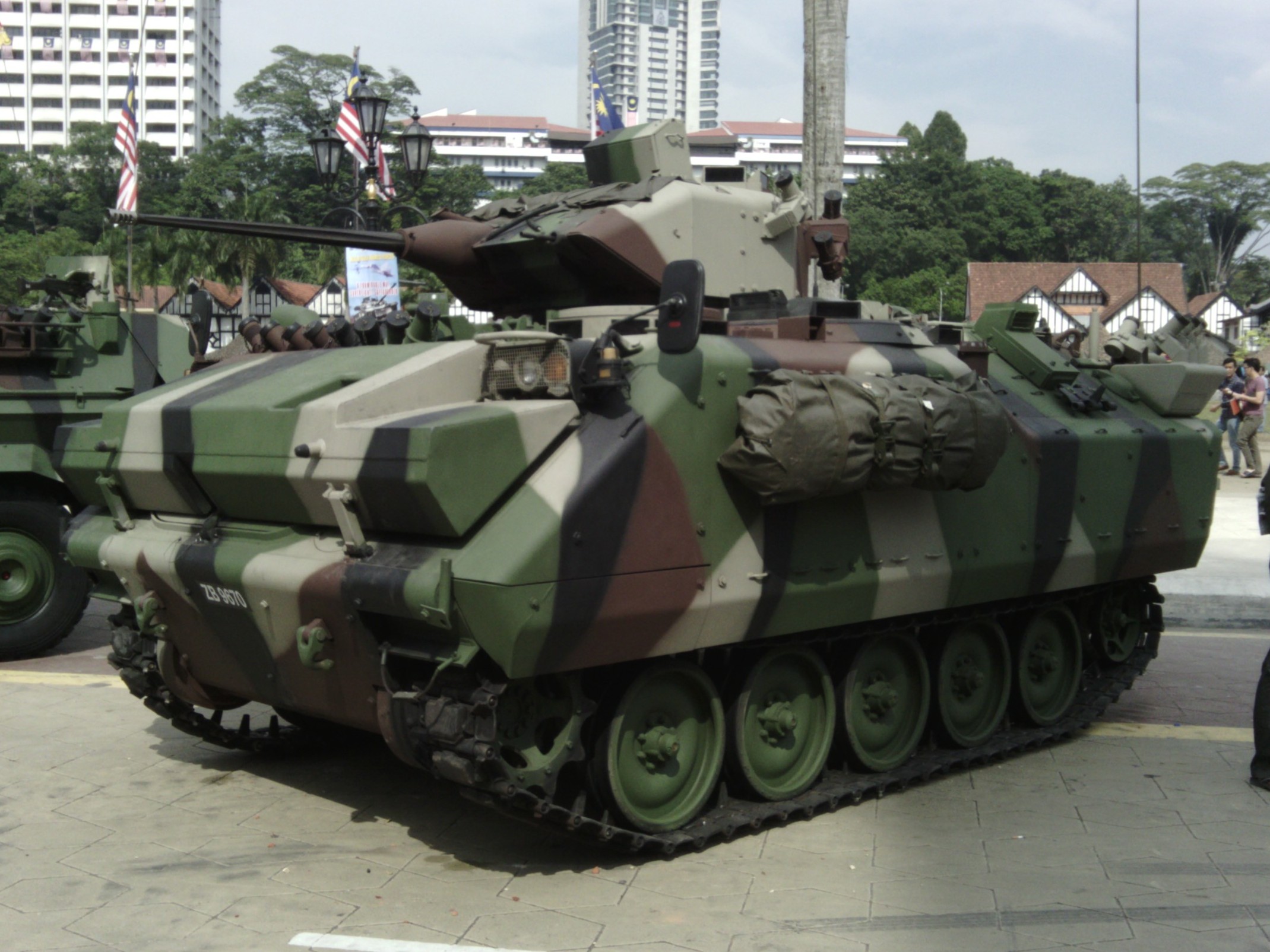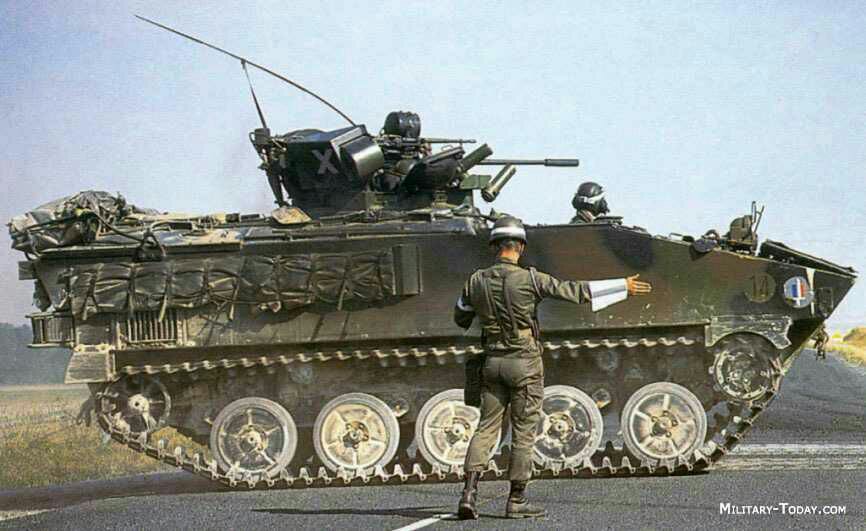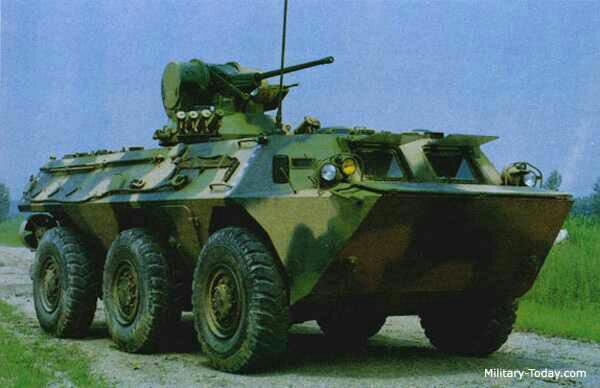Thoughts regarding APC's in Pakistan Army.
PA operates M-113 and M-113 based AL Talha APC's numbering 2000 or more in total out of which 1600 are M-113 and 400 AL Talha.
The basic variants of AL-Talha are :
1. Maaz with ATGM
2. Mouz with SAM
3. Hamza IFV
There are two kinds of engines used in Al-Talha series of AFV's.
1. Detroit Diesel 6V53T, 275 hp
2. KMDB UTD-20, 330 hp
With combat weight of 12.5 Tons, Al Talha is 22-26 hp/Ton. Combat weight means that the APC weighed with fuel topped up, armament and ammo loaded along with full combat load of troops and crew. This weight can however still be increased by adding more armor for protection or steel cage to counter ATGM.
Limited to only two engines that can fit in engine compartment, the speed and manoeuvrability of Talha can suffer especially if it has to keep up with Al Khalid tanks racing along deserts of Sindh.
Talh with add on armor below.
For reference, US Army used 275 hp M-113 with 750 hp M-60 Patton tank.
When M1A1 came up, the M-113 couldnt keep up with it so 600 hp M-2 Bradley was paired up with M1A1. Bradley is not only an ATGm carrier (5-7 missiles) but also a turret and 25mm gun and ammo (300+600 rounds) alongwith 7.62mm machine-guns in addition of 3 crew and 6-7 troops. Even with armor upgrades, the 600hp engine of Bradley gives it good cross country performance. Bradley gets 19hp/Ton power to weight ratio.
Maaz is an ATGM carrier while Mouz is a SP SAM AFV. Both will have atleast 1 ready to fire missile and around 10 in storage. Although these missile carriers have to stop to fire their missiles yet to keep up with AK MBT's, a more hp engine is desirable.
AL-Hamza carries a 25mm gun and its said that Hamza is based on Saad, but it has 5 road wheels like Talha.
The basic PA M-113 variant is A2 version and the ATGM version is M-901 TOW. With a 275 hp engine and armour protection, its hp/ton will also get affected like below.
There are three APC variants in PA inventory which use a bigger engine:
1. Saad
2. Hadeed ARV
3. Sakb ,a logistics vehicle
All have 6 road wheels and a 450 hp Ukrainian engine(some say 400 hp german engine). Unfortunately Saad is not widely produced like AL-Talha.
SAAD is below.
In my opinion with a 100-130 hp more than AL-Talha and an extra road wheel which gives the vehicle increased internal volume and payload, SAAD would have been a better platform to make APC derivatives. ADD on Armour has become a trend in all AFV's nowadays and SAAD wouldnt have faltered.
SAKB obviously needs more power to pull loads and HADEED, an ARV, also has more power than AL-Talha to pull damaged/destroyed APC's.
In comparison, IA BMP-2 has combat weight of 15.7 tons for a 300 hp engine giving it 19 hp/ton ratio.
There are reports/rumour about PA getting VN-1 which is is the PLA’s new wheeled armoured personnel carrier and combat loaded with the basic armour fit, weighs 20 tonnes with engine power 440 hp. Its power to weight ratio of 16.5 kW/t enables the 8 x 8 version to climb a 30° slope, cross a 1.8m trench and climb over a 0.55 m vertical obstacle. The vehicle is 8 m long, 3 m wide, is 2.1m high at the top of the hull and has a ground clearance of 400mm. This vehicle carries a modified Ukrainian Shkval 30 x 165mm automatic cannon equipped two-man turret with wire-guided Hong Jian-73C anti-tank guided missiles, although in service it may carry the ‘Universal’ one man turret mounting a 30mm automatic cannon, coaxial 7.62 machine gun, a Hong Jian-73C ATGM launcher and six 76mm smoke dischargers.
Tracked Vs Wheeled Comparison.
The soil strength, coupled with the vehicle’s characteristic ground pressure, determine a parameter entitled Vehicle Cone Index (VCI), which is a key first-order discriminator of a platform’s mobility. The higher the VCI, or ground pressure, the less mobile the platform becomes.
A vehicle’s mobility is impacted by its traction ability over various soil types (dry, wet, sand, or snow-covered) and its ability to manouver over obstacles, cross gaps, and negotiate varied vegetation. As a general rule of thumb, a lower VCI not only equates to better soft-soil mobility but also indicates better performance on slopes, in sandy terrain, over obstacles/gap crossings and when overriding vegetation.
From a mobility perspective, tracked vehicles offer the best solution for a versatile platform that is required to operate over diverse terrain, including extremely difficult ground, because tracks inherently provide a greater surface area than wheels, resulting in a lower VCI.
Wheeled vehicles inherently attain faster road speeds and, therefore, offer the best solution where unrestricted mobility is not the primary mission driver and on-road usage exceeds off-road usage. As off-road usage dominates the vehicle’s profile, tracked configurations provide significantly better mission travel times.
When a vehicle’s mission requires off-road usage greater than 60 percent and gross vehicle weight exceeds 10 tons, a tracked configuration is preferred for combat roles and even when the gross vehicle weight exceeds 20 tons and off-road usage remains above 60 percent, a tracked configuration is required to guarantee the best mobility for unrestricted, all-weather tactical operations.
SURVIVING IN BATTLEFIELD:
A combat platform’s survivability is dependent on numerous criteria, to include mine and ballistic protection, size/silhouette, and stealthiness. Tracked vehicles, by design, are inherently more compact than wheeled vehicles. The primary reasons for a tracked vehicle’s compactness are reduced suspension clearance, wheel turning clearance, and the absence of multiple transfer cases and drive shafts that are integral to the design of wheeled vehicles,
For a comparable VCI (or ground pressure) at the same gross vehicle weight, wheeled platforms require up to six times more volume for drive train and suspension components than tracked platforms. This results in up to a 28 percent increase in vehicle volume if the same interior volume is maintained making wheeled vehicle a bigger target.
Additionally, as a combat platform’s size increases, so does the gross vehicle weight (provided the same ballistic and mine protection are maintained), which tends to degrade vehicle mobility and deploy-ability.
In general, wheeled platforms are more vulnerable to small arms fire and grenade, mine, and artillery fragments, due to the inherent weakness of wheeled suspension designs, components, and tires. Wheeled vehicles may now be able to continue movement for limited distances at reduced speeds when tires are punctured by small arms rounds, battlefield debris, or shrapnel, due to the advent of run-flat tires. Run-flat tires typically contain a hard rubber insert (some with nitrogen filled cells) inside the tire. The insert bears no vehicle load until the tire is punctured, at which point the load is transferred to the insert and vehicle movement may continue for a limited distance and speed.
On the plus side, wheeled platforms provide a reduced noise signature while moving, primarily due to less vibration and metal to metal contact on running gear. Improvements in track technology (i.e., Roller Chain Band Track) and decoupled running gear have decreased noise signatures for tracked vehicles, but not to the level attained by wheeled platforms.
SUPPORT :
A combat platform’s support is dependent on numerous factors, to include fuel usage, reliability, and O&S costs.
Wheeled vehicles traditionally offer better fuel economy due to the reduced friction losses inherent in wheel/tire suspensions and running gear. The better fuel economy translates into smaller on-board fuel storage requirements or greater operating ranges for wheeled platforms. Wheeled vehicles are intrinsically more reliable than tracked vehicles and, therefore, require less maintenance and supply support (spare parts).
However wheeled vehicles generally have a higher percentage of on-road usage while tracked vehicles incur more off-road usage. Given that wheeled platforms offer better fuel economy and reliability (to an extent), then Operating and Support (O&S) costs are lower than those demonstrated by tracked platforms. This makes wheeled platforms excellent candidates for support roles where overall mileage is high and primarily conducted on road.
TRACKED Vehicle Advantages:
1. Route Flexibility
2. Cross country Mobility
3. Traction on slopes.
4. Less volume/more payload
5. Manoeuvrability
6. Turning Radius
7. Weight Growth Potential
8. Gap and Obstacle Clearing
WHEELED vehicle Advantages:
1. Road Speed
2. Logistics
3. Operating and Support Cost is lesser.









